ANNOTATED BIBLIOGRAPHY OF ALLELOPATHY (1700-2012)- PDF Edition
Editors/Compilers: S. S. Narwal, Chief Editor, Allelopathy Journal, #101,
Sector 14, Rohtak -124001, India. E. Mail:
narwal@allelopathyjournal.com
Rick Willis, Former Lecturer, School of Botany, University of Melbourne, Parkville,
Melbourne, Australia
The term ‘Allelopathy’ was coined by Professor Hans Molisch in 1937. It includes
both inhibitory and stimulatory effects of plants on each other including microorganisms.
Most of the research in this field has been conducted in developed countries during
the last 30-40 years. The first English Book ‘Allelopathy’ written by Dr. E.L. Rice
was published in 1974 and thereafter, many books have appeared on its various aspects
and thousands of research papers on various aspects of allelopathy have been published.
But till now, there is no Comprehensive Bibiliography on Allelopathy. Besides, till
to day, This indicates the great interest World over in this new discipline, because
of its importance in modern Sustainable Agriculture. It has been found that Allelopathy
offers great potential to (a) increase agricultural production (food grains, vegetables,
fruits, forestry), (b) to decrease harmful effects of modern agricultural practices
[multiple cropping, leaching losses from N fertilizers, indiscriminate use of pesticides
(weedicides, fungicides, insecticides, nematicides), tolerant/resistant biotypes
in pest] on soil health/ productivity and environment and (c) to maintain soil productivity
and a pollution free environment for our future generations. It is likely that in
the near future allelopathy will be used in crop production, crop protection, agroforestry
and agrohorticultural practices in developed and developing countries. Allelopathy
may become one of the strategic sciences to reduce the environmental pollution and
to increase agricultural production in Sustainable Agriculture of the 21st Century.
Thus, it is now receiving more attention from agricultural and bioscientists.
In spite of the fact, that now much information is available on different aspects
of Allelopathy, but there is no Comprehensive Bibiliography on Allelopathy,
which provides complete and updated information about the published allelopathy
literature at the International level. Allelopathy scientists interested in finding
literature on a particular aspect have to consult several Books, Journals, Annual
Reports and Magazines etc. This results in wastage of valuable time and energy of
the scientists. Although such information may be available to the Western World
through electronic media, but this facility will not be available to thousands of
allelopathy scientists in the under developed countries, where the importance of
allelopathy is greater. In view of this, Prof. S.S.Narwal has prepared this ANNORTATED
BIBLIOGRAPHY OF ALLELOPATHY, which has taken more than 10- Years, valuable time
and energy to complete this herculean task. It has 10724 Abstracts in 1838 Pages
(A4 size Pages), hence, it is very expansive and to Print and send by Post, thus,
prepared in PDF Edition. It is devided in 5- Volumes. It is the first Comprehensive
Bibiliography on Allelopathy. It includes References up to 2012 and will be up dated
Annually with latest literature. Its main aim is to make available Allelopathy Literature
to the bonafide scientists/students worldwide for their scientific use. In 1989,
I visited Department of Allelopathy, Central Botanical Garden, Kiev, Ukaraine. There
I saw large collection of Allelopathy literature of Prof. A.M. Grodzinsky, very
prominent Internationally renowned Allelopathy Scientist. There I first conceived
idea to prepare the Bibliography. After return from Kiev in 1990, I established
Indian Society of Allelopathy and organized First International Conference on Allelopathy
in 1992 with Prof. E.L. Rice as Chief Guest. In 1992, Dr. V.V. Rao gave me 150 Reprints
on Allelopathy. Then Prof. MAB Mallik, USA sent me Reprints from Prof. Rice collection
after Prof. Rice death. In 2000 Prof. Rick Willis, Department of Botany, University
of Melbourne invited me to his Lab. to prepare this Bibiliography, which laid the
Foundation of this Book.
CONTENTS: All the References (10724) are numbered continuously, listed year-wise
and within the year Alphabetically. Each reference includes Author(s), Year, Title
of paper, Abstract, Name of Journal, Volume Number, full pages. If published in
Book/Report/Dissertation, the full details of Publication viz., Author/Editor, Title,
Name of Publisher, Place of Publication are given.
This Book will be very useful for the allelopathy scientists and graduate students
in agriculture (Agronomists, Entomologists, Nematologists, Plant Pathologists, Horticulturists,
Plant Breeders, Agroforesters, Soil Scientists) and biosciences (Biochemists, Organic
Chemists, Microbiologists, Limnologists), Environmentalists and Farmers, as well
as organizations engaged in sustainable agriculture and organic agriculture.
April 2014; 270 x 160 mm; 1838 pp., PDF: Euro 100.00.

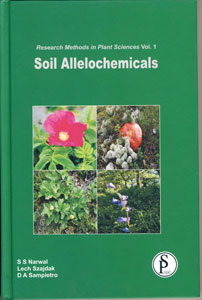 RESEARCH
METHODS IN PLANT SCIENCES VOLUME 1. SOIL ALLELOCHEMICALS
RESEARCH
METHODS IN PLANT SCIENCES VOLUME 1. SOIL ALLELOCHEMICALS
 Series Editor:
Series Editor:
Dr. S.S. Narwal, International Allelopathy Foundation, 101, Sector 14, Rohtak-124
001, Haryana, India
Editors:
Dr. Lech Szajdak, Department of Environmental Chemistry, Institute of Agricultural
and Forest Environment, Polish Academy of Sciences in Poznan, Poland
Dr. D.A. Sampietro, Instituto de Estudios Vegetales, Facultad de Bioquímica,
Química y Farmacia, Universidad Nacional de Tucumán, Tucumán, Argentina.
Allelopathy is a new field of science, as the term ‘Allelopathy’ was coined by Prof.
Hans Molisch, a German Plant Physiologist in 1937. However, no standard methods
are being used by various workers due to lack of compendium on the Techniques, hence,
the results obtained are not easily comparable with each others. Till now lot of
allelopathy resech has been done in various fields of Agricultural and Plant Sciences.
However, there is no compilation of various Research Methods used. Every scientist
is conducting research in his own way. It is causing lot of problems to researchers
working in underdeveloped/Third World Countries in small towns without Library facilities.
Therefore, to make available the standard methods for conducting allelopathy research
independently, this multi-volume book has been planned. Since allelopathy is multi-disciplinary
area of research, hence, volumes have been planned for each discipline.
Prof. S.S. Narwal has planned this multi-volume Book Research Methods in Plant Sciences.
Its 5-volumes (Volume 1. Soil Analysis, Volume 2. Plant Protection and Volume 3.
Plant Pathogens) Volumes 4. Plant Analysis and Volume 5. Plant Physiology) were
published from India. Its 6-Volumes : (6). Cell Diagnostics, (7). Plant Bioassays,
(8). Isolation, Identification and Characterization of Allelochemicals/Natural Products,
(9). Volume 1. Soil Allelochemicals, (10).Volume 2. Soil sickness and (11). Volume
3. Forestry/Agroforestry) were published from USA.
The book is devided into 2 Sections. Section I . Soil Preparation and Preliminary
Analysis includes 3 Chapters (Samples collection, handling and storage,Colorimetric
analysis, TLC and PC analysis).Section II. Analysis of Soil Allelochemicals
has 15 Chapters (Amino acids, Enzymes, Lipids,Carbohydrates, Phenolic compounds,
Terpenoids, Alkaloids, Cyanogenic compounds, Reactive oxygen species, Antioxidant
capacity, Enzymatic, antioxidant system, Adenine and pyridine nucleotides, Vitamins,
Jasmonates).
This book will serve as ready reference in the laboratory or class room and provides
detailed methods for field studies in agriculture and allied fields including allelopathy.
Information provided can be used to determine the different allelochemicals in various
types of Agroecosystems. It will be useful for UG and PG students and researchers,
soil scientists, biochemists, chemists and other plant science specialists. We have
tried to provide appropriate methods to determine allelochemicals in soils. The
users of this book can select suitable methods, according to the available facilities.
March, 2011, 440 + X, H.B. Illustrations, Tables 25, Figures 94.
Price: Euro 80.00,

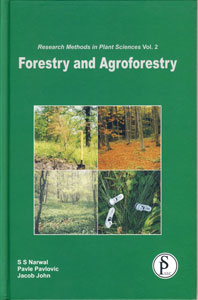 RESEARCH
METHODS IN PLANT SCIENCES VOLUME 2. FORESTRY AND AGROFORESTRY
RESEARCH
METHODS IN PLANT SCIENCES VOLUME 2. FORESTRY AND AGROFORESTRY
 Series Editor:
Series Editor:
Dr. S.S. Narwal, International Allelopathy Foundation, 101, Sector 14, Rohtak-124
001, Haryana, India
Editors:
Dr. Pavle Pavlovic, Department of Ecology, Institute for Biological Research,
University of Belgrade, 11060 Belgrade, Serbia.
Dr. Jacob John, Cropping Systems Research Centre, Kerala Agricultural University,
Thiruvananthapuram 695 002, Kerala, India
Allelopathy is a new field of science, as the term ‘Allelopathy’ was coined by Prof.
Hans Molisch, a German Plant Physiologist in 1937. However, no standard methods
are being used by various workers due to lack of compendium on the Techniques, hence,
the results obtained are not easily comparable with each others. Till now lot of
allelopathy resech has been done in various fields of Agricultural and Plant Sciences.
However, there is no compilation of various Research Methods used. Every scientist
is conducting research in his own way. It is causing lot of problems to researchers
working in underdeveloped/Third World Countries in small towns without Library facilities.
Therefore, to make available the standard methods for conducting allelopathy research
independently, this multi-volume book has been planned. Since allelopathy is multi-disciplinary
area of research, hence, volumes have been planned for each discipline.
Prof. S.S. Narwal has planned this multi-volume BookResearch Methods in Plant Sciences.
Its 5-volumes (Volume 1. Soil Analysis, Volume 2. Plant Protection and Volume 3.
Plant Pathogens) Volumes 4. Plant Analysis and Volume 5. Plant Physiology) were
published from India. Its 6-Volumes : (6). Cell Diagnostics, (7). Plant Bioassays,
(8). Isolation, Identification and Characterization of Allelochemicals/Natural Products,
(9). Volume 1. Soil Allelochemicals, (10).Volume 2. Soil sickness and (11). Volume
3. Forestry/Agroforestry) were published from USA.
The book is devided into 3 Sections.Section I . Laboratory Studies includes
7 Chapters (Fluorescence of biologically active compounds in plant secretory cells,
Allelopathic effects of dominant tree species in forests, Enzymes Bioassays , Laboratory
Bioassay with Agroforestry trees and rhizosphere soil, Hydroponics, Laboratory Bioassays,
Physiological responses of plants to phenolic compounds).Section II. Pot Culture
Studies has 2 Chapters (Soil sickness, Pot Culture Studies) and Section 3. Field
Studies includes 4 Chapters (Trees Physiological and Biochemical Processes,
Multistorey Agroforestry Systems, Enzymes activity and IAA contents in soils, Morphological
measurements)
This book will serve as ready reference in the laboratory or class room and provides
detailed methods for field studies in agriculture and allied fields including allelopathy.
Information provided can be used to determine the different allelochemicals in various
types of Agroecosystems. It will be useful for UG and PG students and researchers,
soil scientists, biochemists, chemists and other plant science specialists. We have
tried to provide appropriate methods to determine allelochemicals in soils. The
users of this book can select suitable methods, according to the available facilities.
We are indebted to the contributors, who have actually used all these methods in
their fields of specialization for the last 10 to 25 years, in accepting challenging
task to prepare chapters for the present book. All of them have made sincere efforts
in presenting the procedure of various methods in very simple language, easily understood
by beginners. We will appreciate to receive valuable suggestions from the students
and researchers, to make further improvements in future editions of this book, to
make it more useful and meaningful.
March, 2011, 250 + X, H.B. Illustrations, Tables 20, Figures 39.
Price: Euro 50.00,

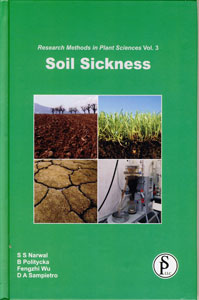 RESEARCH
METHODS IN PLANT SCIENCES VOLUME 3. SOIL SICKNESS
RESEARCH
METHODS IN PLANT SCIENCES VOLUME 3. SOIL SICKNESS
 Series Editor:
Series Editor:
Dr. S.S. Narwal, International Allelopathy Foundation, 101, Sector 14, Rohtak-124
001, Haryana, India
Editors:
Dr. B. Politycka, Department of Plant Physiology, Poznan University of Life
Sciences, 60-637 Poznan, Poland
Dr. Fengzhi Wu, Horticulture College, Northeast Agric. University, Harbin,
Heilongjiang Province, 150030, China
Dr. D.A. Sampietro, Instituto de Estudios Vegetales, Facultad de Bioquímica,
Química y Farmacia, Universidad Nacional de Tucumán, Tucumán, Argentina.
Allelopathy is a new field of science, as the term ‘Allelopathy’ was coined by Prof.
Hans Molisch, a German Plant Physiologist in 1937. However, no standard methods
are being used by various workers due to lack of compendium on the Techniques, hence,
the results obtained are not easily comparable with each others. Till now lot of
allelopathy resech has been done in various fields of Agricultural and Plant Sciences.
However, there is no compilation of various Research Methods used. Every scientist
is conducting research in his own way. It is causing lot of problems to researchers
working in underdeveloped/Third World Countries in small towns without Library facilities.
Therefore, to make available the standard methods for conducting allelopathy research
independently, this multi-volume book has been planned. Since allelopathy is multi-disciplinary
area of research, hence, volumes have been planned for each discipline.
Allelopathy is a new field of science, as the term ‘Allelopathy’ was coined by Prof.
Hans Molisch, a German Plant Physiologist in 1937. However, no standard methods
are being used by various workers due to lack of compendium on the Techniques, hence,
the results obtained are not easily comparable with each others. Till now lot of
allelopathy resech has been done in various fields of Agricultural and Plant Sciences.
However, there is no compilation of various Research Methods used. Every scientist
is conducting research in his own way. It is causing lot of problems to researchers
working in underdeveloped/Third World Countries in small towns without Library facilities.
Therefore, to make available the standard methods for conducting allelopathy research
independently, this multi-volume book has been planned. Since allelopathy is multi-disciplinary
area of research, hence, volumes have been planned for each discipline.
Prof. S.S. Narwal has planned this multi-volume Book Research Methods in Plant Sciences.
Its 5-volumes (Volume 1. Soil Analysis, Volume 2. Plant Protection and Volume 3.
Plant Pathogens) Volumes 4. Plant Analysis and Volume 5. Plant Physiology) were
published from India. Its 6-Volumes : (6). Cell Diagnostics, (7). Plant Bioassays,
(8). Isolation, Identification and Characterization of Allelochemicals/Natural Products,
(9). Volume 1. Soil Allelochemicals, (10).Volume 2. Soil sickness and (11). Volume
3. Forestry/Agroforestry) were published from USA.
Soil sickness is important area of research worldwide, however, little research
has been done because it is complex phenomenon and caused by many factors (nutrients
exhaustion, deterioration of soil structure, physical and chemical properties, development
of phytopathogenic microflora, one-sided development of some groups of soil microflora,
pest’s multiplication (nematodes), changes in pH, accumulation of phytotoxic substances
in soil). This field did not receive the attention it deserved, however, in past
few years, there is new impetus on soil sickness research mainly on autotoxicity
of crops and trees. Hence Allelopathy Journal published special issue on soil sickness
[Guest Editors: B. Politycka, Poland and J.Q. Yu, China Volume 18(1) 2006]. Till
now there is only one book, A.M. Grodzinsky (1979). Allelopathy in Soil Sickness
(Russian, English translated 2006). This book on methodology may initiate more research
on soil sickness.
The book is divided in 2 sections: Section I. Abiotic factors, has 5 Chapters (Soil
sickness: An overview, Plant Nutrients, Soil Salinity and Acidity, Soil Compaction,
Soil Organic Matter), Section II. Biotic factors has 9 Chapters (Phytotoxic Substances,
Soil Microorganisms and Soil-Borne Diseases, Soil Enzymes, Insects in Agrosystems,
Plant Parasitic Nematodes, Weed Studies, Soil Sickness and Productivity, Morpho-anatomical
changes in crops under soil sickness, Soil Sickness in Forestry)
This book will serve as ready reference in laboratory/greenhouse/field studies and
in class room. It helps to solve many problems of soil sickness. It will be useful
for UG and PG students pursing allelopathic work at laboratory, greenhouse and field
levels and to biologists and ecologists. We have tried to provide appropriate solutions
to the problems of soil sickness. The users of this book can select suitable methods,
according to the available facilities.
We are indebted to the contributors, who have actually used all these methods in
their fields of specialization for the last 10 to 25 years, in accepting challenging
task to prepare chapters for the present book. All of them have made sincere efforts
in presenting the procedure of various methods in very simple language, easily understood
by beginners. We will appreciate to receive valuable suggestions from the students
and researchers, to make further improvements in future editions of this book, to
make it more useful and meaningful.
March, 2011, 278 + X, H.B. Illustrations, Tables 24, Figures 65.
Price: Euro 50.00,

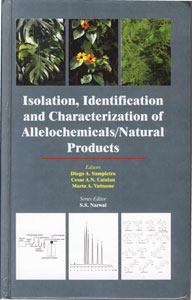 ISOLATION,
IDENTIFICATION AND CHARACTERIZATION OF ALLELOCHEMICALS/NATURAL PRODUCTS
ISOLATION,
IDENTIFICATION AND CHARACTERIZATION OF ALLELOCHEMICALS/NATURAL PRODUCTS
 Series Editor:
Series Editor:
S.S. Narwal, International Allelopathy Foundation, 101, Sector - 14, Rohtak
-124 001, India
Editors:
D.A. Sampietro, M. A. Vattuone, Instituto de Estudios Vegetales, Uni Nacional
de Tucuman, Tucuman,Argentina
C.A.N. Catalan, Instituto de Quimica Organica, Universidad Nacional de
Tucuman, Tucuman, Argentina.
Discovery of new bioactive compounds from natural products/secondary metabolites
has played a major role in the development of organic chemistry. The ecological
role of these allelochemicals/natural products as pesticides (herbicides, insecticides
and fungicides) for ecological/organic sustainable agriculture has recently drawn
great attention, due to increasing public concern against synthetic pesticides.
Current researches on natural products emphasize not only the need of structural
elucidation of the isolated compounds but also of their natural biological function
and possible utility for human purposes. These concerns require reliable protocols
for such studies, which sometimes are not available worldwide.
The Book is devided in 4 Sections. Section I. Sample Collection, Handling and Storage,
includes 2 Chapters (Soil, air and water samples and Plant sampling and Sample Preparation).
Section II. Isolation, Identification and Structural Elucidation has 8 Chapters
(Colorimetric Reactions, TLC and PC, HPLC and LC- MS, Chromatography and Spectroscopy
of alkaloids, GC and GC MS of terpenoids, GC and GC-MS for non-volatile compounds,
Spectrometry: Ultraviolet and Visible spectra, Spectrometry: Infrared Spectra).
Section III. Biological Activity of Natural Products consists of 6 Chapters (Bioassays
with whole plants and plant organs, Bioassays on Plants: Plant cells and organelles,
Bioassays on Microorganisms: Antifungal and antibacterial activities, Bioassays
for Antioxidant, Genotoxic, Mutagenic and Cytotoxic activities, Bioassays: Inhibitors
of insect chitin-degrading enzymes and Bioassays: insect behaviour, development
and survival). Section IV. Appendices (Abbreviations, Chemical formulae and molecular
weight of solvents and reagents, Molecular weight of organic compounds).
This book will serve as ready reference in the laboratory or class room and help
to solve many problems of Isolation, Identification and Characterization of Allelochemicals/Natural
Products. It will be useful for UG and PG students pursing allelopathic work to
Isolate, Identify and Characterize Allelochemicals/Natural Products and to Organic
Chemists. We have tried to provide appropriate solutions to the problems of Isolation,
Identification and Characterization of Allelochemicals/Natural Products., The users
of this book can select suitable methods, according to the available facilities.
July 2009: 250 x 160 mm; VIII + 548 pp. 43 Tables, 174 Figures, Hard Back. Published,
USA.
Price: Euro 100.00,

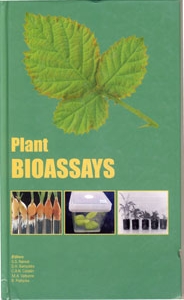 PLANT
BIOASSAYS
PLANT
BIOASSAYS
 Series Editor:
Series Editor:
S.S. Narwal, International Allelopathy Foundation, 101, Sector - 14, Rohtak
-124 001, India
Editors:
: D. A. Sampietro, M.A. Vattuone, Cesar A.N. Catalan, Instituto de Estudios
Vegetales, Facultad de Bioquímica, Universidad Nacional de Tucuman, Espana 2903,
CP 4000, Tucuman, Argentina.
B. Polyticka, Department of Plant Physiology, A. C. Agri University, 60-637
Poznan, Wolynska 35, Poland.
Allelopathy is a new field of science, as the term ‘Allelopathy’ was coined in 1937.
However, researchers are not using the standard methods due to lack of compendium
on the Techniques, hence, the results obtained are not easily comparable with each
others. Current research on allelopathy emphasizes not only on Plant-Plant Interactions
but also interactions involving the Plant-Microorganisms and Plant-Phytophagous
organisms. These concerns require reliable protocols for such studies, which sometimes
are not available worldwide. Hence, this book has been written to provide information
about all aspects of plant bioassays. The Book is divided in 4 Sections. Section
I. Plant-Plant Interactions, includes 5 chapters (Laboratory Assays in Allelopathy,
Pollen Allelopathy, Genetic Toxicology and Environmental Mutagenesis in Allelopathic
Interactions, Comet Assay in Higher Plants). Section II. Plant-Microorganism Interactions
has 5 chapters (Biochemical Aspects of Plant pathogen Interactions, Plant Growth
Promoting Rhizobacteria, Hypersensitive response, Plant Virus interactions, Search
for antiphytopathogenic compounds involved in plant defence). Section III. Plant-Phytophagous
Interactions consists of 2 chapters (Search for phytochemicals to control
plant-insect interactions and Bioassays on plant nematode interactions). Section
IV. Appendices (Abbreviations, Chemical formulae and molecular weight of
solvents and reagents Molecular weight of organic compounds).
We hope that protocols and criteria provided will be helpful to students, researchers
and teachers for Laboratory/Greenhouse/Field Research and Practical Classes, to
solve many problems of plant bioassays. It will be useful for UG and PG students
pursing allelopathic research in laboratory, greenhouse and field studies and to
Biologists and Ecologists. The users of this book can select suitable methods, according
to the available facilities.
July 2009: 250 x 150 mm; XVI + 334 pp. 34 Tables, 129 Figures, Hard Back. Published,
USA.
Price: Euro 60.00,

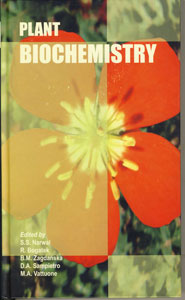 PLANT
BIOCHEMISTRY
PLANT
BIOCHEMISTRY
 Series Editor:
Series Editor:
S.S. Narwal, International Allelopathy Foundation, 101, Sector - 14, Rohtak
-124 001, India
Co-Editors :
R. Bogatek, B.M. Zagdanska, Department of Plant Physiology, University of Life
Sciences, Warsaw, Poland.
D. A. Sampietro, M.A. Vattuone - Instituto de Estudios Vegetales, Facultad
de Bioquímica, Quimica Y. Farmacia, Universidad Nacional de Tucuman, Espana 2903,
CP 4000, Tucuman, Argentina.
Allelopathy is a new field of science, as the term ‘Allelopathy’ was coined in 1937.
However researchers are not using the Standard methods for research, due to lack
of compendium on the Techniques, hence, the results obtained are not easily comparable
with each other. Therefore, to make available the Standard methods for conducting
allelopathy is multi-disciplinary area of research, hence, separate books have been
planned for each discipline. Understanding of allelopathic phenomenon and the effect
of allelochemicals on receptor plants requires an interdisciplinary approach. The
effects of allelochemicals action can be detected at different levels of plant organization:
Molecular, structural, biochemical, physiological and ecological. This book has
been written to provide information about all aspects of Plant Biochemistry. It
is divided in 3 Sections: Section I. Preparation of Plant Material, has 1
chapter (Extraction and processing of plant material for biochemical assays). Section
II. Biochemical Assays, consists of 17 chapters (Amino acids, Proteins,
Enzymes, Carbohydrates, Lipids, Nucleic acids, Phenolic compounds, Polyphenols and
lignins, Terprnoids, Amines, Alkaloids, Cyanogenic compounds, Reactive oxygen species,
Antioxidant capacity, Enzymatic antioxidant system, Adenine pyridine nucleotides
and Plant Hormones). Section III. Appendices (Abbreviations, Chemical formulae
and molecular weight of solvents and reagents).
This book will serve as ready reference in laboratory/greenhouse/field studies and
in class room. It will help to solve many problems of Plant Biochemistry. It will
be useful for UG and PG students pursuing allelopathic research in laboratory, greenhouse
and field studies and to Biologists and Ecologists. The users of this book can select
suitable methods, according to the available facilities.
July 2009: 250 x 150 mm; XIV + 634 pp. 27 Tables, 148 Figures, Hard Back. Published,
USA.
Price: Euro 100.00,

ALLELOCHEMICALS : ROLE IN PLANT-ENVIRONMENT INTERACTIONS
Series Editor:
S.R. Leicach, Catedra de Quimica de Biomoleculas, Departmento de Biologica,
Aplicada y Alimentos, Facultad de Agronomia, Universidad de Buenos Aires, Avda San
Martin 4453, CP 1417, Buenos Aires, Argentina.
D.A. Sampietro, Catedra de Fitoquimica, Instituto de Estudios Vegetales,
Facultad de Bioquimica, Quimica y Farmacia, Universidad Nacional de Tucuman, Espana
2903, CP 4000, Tucuman, Argentina. S.S. Narwal, International Allelopathy
Foundation, 101, Sector - 14, Rohtak -124 001, India.
During evolution, the plants developed new biosynthetic pathways to produce secondary
metabolites (flavonoids, alkaloids, cyanogenic glycosides, glucosinolates, phenolics
and tannins) known as allelochemicals. These provide adaptative advantages to plants
for survival against herbivores, pests (insects, nematodes, pathogens, weeds), environmental
stresses and other plants. They can be considered as the chemical language of plants,
which continuously changes and increases in complexity with their evolution. Allelopathy
phenomenon refers to inhibitory or stimulatory biochemical interactions between
the plant-plants, plant-predators and plant-pathogens mediated by plant allelochemicals
released into the environment as leachates, volatiles, root exudates and decomposition
of plant residues. The allelochemicals affects numerous biochemical reactions/metabolic
processes (photosynthesis and respiration etc) in plants and such action may be
determined at molecular structural, biochemical, physiological and ecological levels.
This book aims to provide an overview of structure, origin and mode of release of
plant allelochemicals and their biological roles in allelopathic interactions. The
book contains Introduction and 11 Chapters,Chapter I: Allelochemicals, describes
main groups of secondary metabolites involved in allelopathic interactions.Chapter
2: Plant-Environment Interactions, deals with molecular inter/intraspecific
interactions between the plants.Chapter 3: Allelopathy, is an overview of
concept and definition of Allelopathy Science. Chapter 4: Releasing Mechanisms,
describes modes of release of allelochemicals from donor plants.Chapter 5: Bioassay,
explains bioassay currently used in allelopathy research.Chapter 6: Localization
and Bioactivity Range, describes how organ, ontogenic state and cellular
compartmentalization affects the allelochemicals production and accumulation etc.
Chapter 7: Environmental Modulation, describes how the environmental factors
influence the allelochemicals production/release from donor plants and response
of receptor plants. Chapter 8: Mechanisms of Action, explains current knowledge
about the allelochemicals affects on growth and development of receptor plants.
Chapter 9: Impact on Ecosystems, describes how the allelochemicals affects
the natural and managed ecosystems.Chapter 10: Applications of Allelopathic Interactions,
provides current uses of allelopathy in agriculture.Chapter 11: Separation and Identification
of Allelochemicals, explains general tips for phytochemical studies in allelopathy
research levels. It will be very useful to Students and Researchers in Biology Agriculture,
Organic Chemistry and other Plant Sciences.
July 2009: 220 x 145 mm; X + 190 pp. 86 Figures, Hard Back. Published, USA.
Price: Euro 40.00,

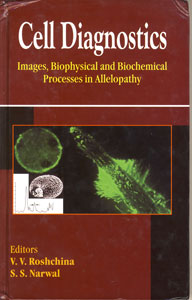 CELL
DIAGNOSTICS
CELL
DIAGNOSTICS
 Series Editor:
Series Editor:
V.V. Roschina, Institute of Cell Biophysics, Russian Academy of Sciences, Puschchino,
Moscow, Russia
S.S. Narwal, International Allelopathy Foundation, 101, Sector - 14, Rohtak
-124 001, India.
Modern methods of Cell Diagnostics includes improved microscopy (Electron, Luminescence,
Laser Scanning Confocal, Optical Coherence), Microspectrofluorimetry, and analytical
biochemical assays. These methods may be applied to study the chemical interactions
between the living organisms called “allelopathy” as well as in other fields of
plant cell biology. This methodology book describes the recent approaches to study
suitable model cellular systems for analysis of intercellular interactions, microscopic
imaging of cells in the diagnostics of plant allelopathic effects and analytical
estimation of some biochemical and biophysical processes occurring between the contacting
cells.
CONTENTS
Section 1. Cellular Model Systems: (i). Allelopthy and plant cell diagnostics,
(ii). Cellulr models as biosensors, (iii). Microalgae for determing the effects
of allelochemicals, (iv). Bryophytes to test allelochemicals in vitro. Section
2. New Methods of Microscopy in Cellular Diagnostics: (v). Microscopic methods
to study morpho-cytological events during the seed germination, (vi). Optical coherence
tomography and optical coherence microscopy to monitor water absorption, (vii).
Optical coherence microscopy: study of plant secretory structures, (viii). Laser-scanning
confocal microscopy (LSCM): study of plant secretory cell, (ix). Luminescent cell
analysis in allelopathy. Section 3. Methods of Analytical Biochemistry and Biophysics:
(x). Biochemical approach to study oxidative damage in plants exposed to allelochemical
stress: A case study, (xi). Cholinesterase activity as a biosensor reaction for
natural allelochemicals: pesticides and pharmaceuticals, (xii). Methods to study
effect of allelochemicals on algae membrane integrity, (xiii). Total phenolics and
phenolic acids in plants and soils, (xiv). Computational methods to study properties
of allelochemicals and modelling of molecular interactions in allelopathy, (xv).
Allelopathic pollen: isolating the allelopathic effects.
This book will serve as a Handbook to biology researchers and students working on
plant and animal cells. All the methods have been described in detail.
July 2007: 245 x 157 mm; XX + 204 pp. Hard Back. Published, USA. Not Available.
Price: Not Avaiable,

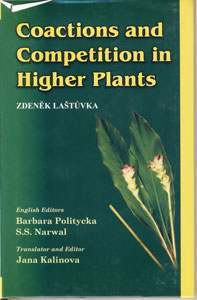 COACTIONS
AND COMPETITION IN HIGHER PLANTS
COACTIONS
AND COMPETITION IN HIGHER PLANTS
 Z. Lastuvka, Department of Plant Physiology, University of Brno, Brno,
Czech Republic
Z. Lastuvka, Department of Plant Physiology, University of Brno, Brno,
Czech Republic
Editor: B. Politycka, Department of Botany, Agricultural University, Wolynska
35, 60-637, Poznan, Poland.
S.S. Narwal, International Allelopathy Foundation, 101, Sector - 14, Rohtak
-124 001, India.
Translator and Editor: J. Kalinova, Department of Plant Production, Faculty
of Agriculture, University of South Bohemia, Ceske Budejovice, Czech Republic.
This is the first book on ‘Coactions and Competition in Plants’ worldwide.
It was translated from Czech language, because the English is read in most countries
of the world, hence, the allelopathy scientists would be able to know the phenomenon
of coactions and competition in plants. The allelopathic interactions in coactions
and competition in higher plants greatly influences the productivity of field crops,
fruits trees and forest trees in natural and managed ecosystems. In tropical and
subtropical countries, many crops are grown in crop mixtures, owing to their several
advantages. Likewise, in natural forests, many tree spp. grow together, besides
many herbs and shrubs grow underneath their canopy. Now due to increased human population,
the farmers to meet the diverse requirements of their families, grows several crops
with trees, called Agroforestry. However, little information is available about
the allelopathic interactions in coactions and competition in the above agro-ecosystems.
Worldwide, it is the only book available on these important aspects. This book consists
of 8 Chapters viz., (i) Basic principles, (ii) Competition, (iii) Secondary compounds,
(iv) Non-contact coactions, (v) Antagonistic contact coactions, (vi) Synergic contact
coactions, (vii) Conclusions, (viii) References and Appendix. It is hoped, that
this book will provide inspiration and in-depth knowledge of the coactions and competition
in higher plants.
This book will be very useful for the Researchers, Teachers and Students of Biosciences
(Plant Ecology, Plant Physiology, Biochemistry, Microbiology) and Agricultural Sciences
(Agronomy, Forestry etc.).
July 2007: 245 x 160 mm; XII + 216 pp. Hard Back. ISBN: 81-7233-478-8.
Price: Euro 40.00,

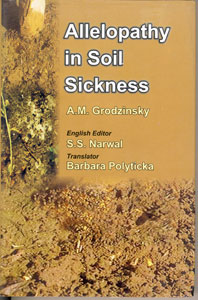 ALLELOPATHY
IN SOIL SICKNESS [Translated from Russian language (Published 2006)]
ALLELOPATHY
IN SOIL SICKNESS [Translated from Russian language (Published 2006)]
 A.M. Grodzinsky, Department of Allelopathy, Central Botanical Garden,
Kiev, Ukraine
Editor: S. S. Narwal, Haryana Agricultural University, Hisar-125 004, India
Editors:Translator: B. Polyticka, Department of Plant Physiology, St. Augustus
Agricultural University, Poznan, Poland.
A.M. Grodzinsky, Department of Allelopathy, Central Botanical Garden,
Kiev, Ukraine
Editor: S. S. Narwal, Haryana Agricultural University, Hisar-125 004, India
Editors:Translator: B. Polyticka, Department of Plant Physiology, St. Augustus
Agricultural University, Poznan, Poland.
This is the first English translation of the classic Book Allelopathy in Soil Sickness,
the first Book on Soil Sickness from Russian language. It was translated because
English is read in most countries of the world, hence, the allelopathy scientist
would be able to know the phenomenon of Soil Sickness. In the past this problem
was mainly reported from Temperate countries of Europe, USA etc. But now, this problem
is also increasing in the tropical and subtropical countries due to multiple cropping
systems e.g. rice-wheat, rice- rice- rice, sugarcane ratoons, vegetable based cropping
systems etc in several Asian countries. It is hoped this book will provide inspiration
and in-depth knowledge of the complex problem of Soil Sickness. This book consists
of 9 chapters viz., (i). History of soil sickness, (ii). Soil sickness in field
crops, (iii). Soil sickness in fruit trees, (iv). Soil sickness in flower cultivation,
(v). Chemical nature of toxins, (vi). Physiological and biochemical interactions
of toxins, (vii). Role of microorganisms in soil sickness and to restore soil fertility,
(viii). Determining allelopathic soil toxicity, (ix). Conclusions and (x). References.
Prof. Grodzinsky was an outstanding Allelopathy scientist, who is called "Father
of Allelopathy in USSR". He worked on Allelopathy for 23 years (1965-1988). He edited
16 Books on Allelopathy (1965-1987, highest number of Books edited by any other
scientist Worldwide) and authored more than100 research papers. In world, he established
the first Department of Allelopathy, Central Botanical Garden, Kiev, Ukraine.
January 2006: 225 x 150 mm; XV + 262 pp. Hard Back: Euro 40.00. ISBN: 81-7233-423-0.
Price: Euro 40.00,

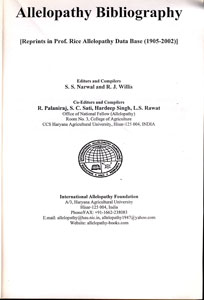 ALLELOPATHY
BIBLIOGRAPHY (1905-2004)
ALLELOPATHY
BIBLIOGRAPHY (1905-2004)
 Editor and Compiler: S. S. Narwal, 101, Sector 14, Rohtak -124001,
India. E. Mail: narwal_2016@yahoo.com
Editor and Compiler: S. S. Narwal, 101, Sector 14, Rohtak -124001,
India. E. Mail: narwal_2016@yahoo.com
The term Allelopathy was coined by Professor Hans Molisch in 1937 and includes both
inhibitory and stimulatory effects of plants on each other including microorganisms.
Most of the research in this field has been conducted in developed countries during
the last 30-40 years. The first book on Allelopathy written by Dr. E.L. Rice was
published in 1974 and thereafter, many books have appeared on its various aspects,
but till now, there is no Allelopathy Data Base. Besides, during this period, thousands
of research papers on various aspects of allelopathy have been published. This indicates
the great interest World over in this new discipline, because of its importance
in modern Sustainable Agriculture. It has been found that Allelopathy offers great
potential to (a) increase agricultural production (food grains, vegetables, fruits,
forestry), (b) to decrease harmful effects of modern agricultural practices [multiple
cropping, leaching losses from N fertilizers, indiscriminate use of pesticides (weedicides,
fungicides, insecticides, nematicides), tolerant/resistant biotypes in pest] on
soil health/ productivity and environment and (c) to maintain soil productivity
and a pollution free environment for our future generations. It is likely that in
the near future allelopathy will be used in crop production, crop protection, agroforestry
and agrohorticultural practices in developed and developing countries. Allelopathy
may become one of the strategic sciences to reduce the environmental pollution and
to increase agricultural production in Sustainable Agriculture of the 21st Century.
Thus, it is now receiving more attention from agricultural and bioscientists.
In spite of the fact, that now much information is available on different aspects
of Allelopathy, but there is no Allelopathy Data Base which provides complete and
updated information about the published allelopathy literature at the International
level. Allelopathy scientists interested in finding literature on a particular aspect
have to consult several Books, Journals, Annual Reports and Magazines etc. This
results in wastage of valuable time and energy of the scientists. Although such
information may be available to the Western World through electronic media, but
this facility will not be available to thousands of allelopathy scientists in the
under developed countries, where the importance of allelopathy is greater. In view
of this, the International Allelopathy Foundation has established the Prof. Rice
Allelopathy Data Base (RADB) in the loving memory of Prof. Elroy Leon Rice, Norman,
Oklahoma, USA popularly known as Father of Allelopathy. Its main aim is to make
available Allelopathy Literature (Photocopies of Reprints, Abstracts) to the bonafide
scientists/students worldwide for their scientific use.
Contents: All the Reprints (about 5500) available in the Data Base are numbered
continuously, listed year-wise and within the year Alphabetically. Each entry includes
full Reference about the publication viz., Author(s), Year, Title of paper, Name
of Journal, Volume Number, full pages. If published in book, full details of book
viz., Author/Editor, Title, Name of Publisher, Place of Publication are given. Subject
Index is given at the end.
This Book will be very useful for the allelopathy scientists and graduate students
in agriculture (agronomists, entomologists, nematologists, plant pathologists, horticulturists,
plant breeders, agroforesters, soil scientists) and biosciences (biochemists, organic
chemists, microbiologists and limnologists), environmentalists and farmers, as well
as organizations engaged in sustainable agriculture and organic agriculture. This
book will serve as Bibliography.
May 2006; 300 x 220 mm; 595 pp., Paper Back: Euro $ 50.00.
Price: Euro 50.00,

RESEARCH METHODS IN PLANT SCIENCES, ALLELOPATHY : VOLUME 1. SOIL SCIENCE
Series Editor: S.S. Narwal, Department of Agronomy, Haryana Agricultural
University, Hisar- 125 004, India Editors: S.S. Dahiya and J.P.Singh,
Department of Soils, Haryana Agricultural University, Hisar- 125 004, India
Allelopathy is a new field of science, as the term ‘Allelopathy’ was coined by Prof.
Hans Molisch, a German Plant Physiologist in 1937. Till now lot of Allelopathy research
work has been done in various fields of Agricultural and Plant Sciences. However,
there is no compilation of various Research Methods used. Every scientist is conducting
research in his own way. It is causing lot of problems to researchers working in
underdeveloped/Third World Countries in small towns without Library facilities.
Therefore, to make available the standard methods for conducting allelopathy research
independently, this multi-volume book has been planned. Since allelopathy is multi-disciplinary
area of research, hence, volumes have been planned for each discipline. The Book
series“Research Methods in Plant Science: Allelopathy” aims to provide basic
information about the various methods to Researchers so that he can conduct research
independently. The methods have been described in a simple way just like “DO IT
YOURSELF” Book. Now it is hoped that researchers can do research independently by
following steps given in this Book series.
CONTENTS
1. Instrumentation, 2. Preparation of solutions, 3. Collection and preparation of
soil and plant samples, 4. Pot culture techniques, 5. Inherent soil properties,
6. Soil structural parameters, 7. Soil moisture, 8. Pore space, 9. pH and soluble
salts, 10. Exchange capacity and exchangeable cations, 11. Carbon, 12. Nitrogen,
13. Phosphorus, 14. Potassium and sodium, 15. Calcium and magnesium, 16. Sulphur,
17. Micronutrients, 18. Toxic metals, 19. Soil ecosystem : Microbiological process
and their significance in soil, 20. Biological nitrogen fixation
This book provides complete information for Soil Analysis in simple and lucid language.
The Figures/illustrations have been given at appropriate places in text. It will
prove very useful to undergraduate and post graduate students and teaching Faculty
for Class Room and Laboratory experiments as well as for research.
August 2004: 240 x 160 mm; XVII + 354 pp. Hard Back: Euro 40.00. ISBN: 81-7233-384-6.
Price: Euro 40.00,

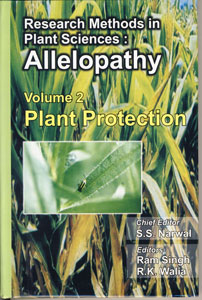 RESEARCH
METHODS IN PLANT SCIENCES, ALLELOPATHY : VOLUME 2. PLANT PROTECTION
RESEARCH
METHODS IN PLANT SCIENCES, ALLELOPATHY : VOLUME 2. PLANT PROTECTION

Series Editor: S.S. Narwal, Department of Agronomy, Haryana Agricultural
University, Hisar- 125 004, India
Editors: Ram Singh, Department of Entomology, Haryana Agricultural University,
Hisar- 125 004, India R.K. Walia, Department of Nematology, Haryana Agricultural
University, Hisar- 125 004, India
Allelopathy is a new field of science, as the term ‘Allelopathy’ was coined by Prof.
Hans Molisch, a German Plant Physiologist in 1937. Till now lot of Allelopathy research
work has been done in various fields of Agricultural and Plant Sciences. However,
there is no compilation of various Research Methods used. Every scientist is conducting
research in his own way. It is causing lot of problems to researchers working in
underdeveloped/Third World Countries in small towns without Library facilities.
Therefore, to make available the standard methods for conducting allelopathy research
independently, this multi-volume book has been planned. Since allelopathy is multi-disciplinary
area of research, hence, volumes have been planned for each discipline. The Book
series “Research Methods in Plant Science: Allelopathy” aims to provide basic
information about the various methods to Researchers so that he can conduct research
independently. The methods have been described in a simple way just like “DO IT
YOURSELF” Book. Now it is hoped that researchers can do research independently by
following steps given in this Book series.
CONTENTS
1. Bioassay techniques for evaluation of allelochemicals as insecticides, 2. Bioassay
techniques for evaluation of allelochemicals as antibiosis compounds, 3. Bioassay
techniques for evaluation of allelochemicals as insect attractants and arrestants,
4. Bioassay techniques for evaluation of phytohormones as insecticides, 5. Methods
to study effect of allelochemicals on insect natural enemies, 6. Methodology to
study the effect of cropping systems on insect pest complex, 7. Introduction to
plant parasitic nematodes, 8. General nematological techniques, 9. Identification
of economically important plant parasitic nematodes, 10. Applied allelopathy techniques,
11. Methods to screen allelopathic rice varieties against weeds.
This Book provides complete information about the various techniques used for Allelopathy
Research in the field of Entomology, Nematology and Weeds. It is written in a simple
and lucid language. It will be very useful to undergraduate and Post graduate students
and Faculty for used in Class room and Laboratory experiments and research.
August 2004: 240 x 160 mm; XVII + 292 pp. Hard Back: Euro 40.00. ISBN: 81-7233-385-4.
Price: Euro 40.00,

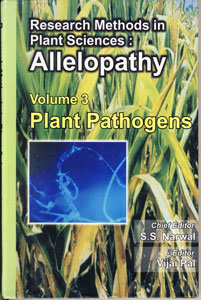 RESEARCH
METHODS IN PLANT SCIENCES, ALLELOPATHY : VOLUME 3. PLANT PATHOGENS
RESEARCH
METHODS IN PLANT SCIENCES, ALLELOPATHY : VOLUME 3. PLANT PATHOGENS

Series Editor: S.S. Narwal, Department of Agronomy, Haryana Agricultural
University, Hisar- 125 004, India
Editor: V.P. Sharma, Department of Plant Pathology, Haryana Agricultural
University, Hisar- 125 004, India
Allelopathy is a new field of science, as the term ‘Allelopathy’ was coined by Prof.
Hans Molisch, a German Plant Physiologist in 1937. Till now lot of Allelopathy research
work has been done in various fields of Agricultural and Plant Sciences. However,
there is no compilation of various Research Methods used. Every scientist is conducting
research in his own way. It is causing lot of problems to researchers working in
underdeveloped/Third World Countries in small towns without Library facilities.
Therefore, to make available the standard methods for conducting allelopathy research
independently, this multi-volume book has been planned. Since allelopathy is multi-disciplinary
area of research, hence, volumes have been planned for each discipline. The Book
series “Research Methods in Plant Science: Allelopathy” aims to provide basic
information about the various methods to Researchers so that he can conduct research
independently. The methods have been described in a simple way just like “DO IT
YOURSELF” Book. Now it is hoped that researchers can do research independently by
following steps given in this Book series.
During the last two decades, methods in plant pathology have undergone material
changes. It therefore, became necessary to prepare a Comprehensive Laboratory Guide
covering all the methods used in phytopathological and plant pathogens research.
An attempt has been made in this volume to include most methods related to plant
pathology.
CONTENTS
1. Introduction to phytopathogenic fungi, 2. Isolation and identification of fungal
plant pathogens, 3. Exploitation of higher plants for the control of plant mycoses,
4. Exploitation of fungal antagonists for the control of plant mycoses, 5. Vesicular
arbuscular mycorrhizal fungi, 6. Bioassays to detect and identify allelochemicals
in plants using zoospores of phytopathogens the peronosporomycetes, 7. Culture media,
8. Introduction to phytopathogenic bacteria, 9. Genera of phytopathogenic bacteria,
10. Symptoms of plant bacterioses, 11. Collection of disease specimens of plant
bacterioses, 12. Association of phytopathogenic bacteria with disease specimens,
13. Isolation of phytopathogenic bacteria, 14. Testing pathogenic potential of isolated
bacteria, 15. Exploation of higher plants for the control of plant bacterioses,
16. Rhizosphere and phylloplane bacteria to control plant bacterioses, 17. Common
culture media for phytopathogenic bacteria, 18. Introduction to plant viruses, 19.
Isolation, purification and detection of plant viruses
This book will be helpful for plant pathologists, plant science specialists and
students to serve as ready reference in the laboratory or class room and will facilitate
to solve various field problems of agriculture and allied fields including allelopathy.
An effort has been made in preparing this book to seek appropriate solution to the
phytopathological problems even without using the most sophisticated laboratory
equipments. The users of this book can select suitable methods for various objectives
according to the available facilities in his/her College/Institute. It is written
in a simple and lucid language. It will be very useful to undergraduate and Post
graduate students and Faculty for used in Class room and Laboratory experiments
and research.
August 2004: 240 x 160 mm; XVII + 236 pp. Hard Back: Euro 40.00. ISBN: 81-7233-386-2
Price: Euro 40.00,

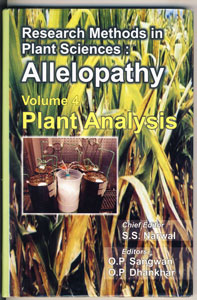 RESEARCH
METHODS IN PLANT SCIENCES, ALLELOPATHY : VOLUME 4. PLANT ANALYSIS
RESEARCH
METHODS IN PLANT SCIENCES, ALLELOPATHY : VOLUME 4. PLANT ANALYSIS

Series Editor: S.S. Narwal, Department of Agronomy, Haryana Agricultural
University, Hisar- 125 004, India
Editors: O.P. Sangwan, O.P. Dhankhar, Department of Soil Science, Haryana
Agri. University, Hisar- 125 004, India
Allelopathy is a new field of science, as the term ‘Allelopathy’ was coined by Prof.
Hans Molisch, a German Plant Physiologist in 1937. Till now lot of Allelopathy research
work has been done in various fields of Agricultural and Plant Sciences. However,
there is no compilation of various Research Methods used. Every scientist is conducting
research in his own way. It is causing lot of problems to researchers working in
underdeveloped/Third World Countries in small towns without Library facilities.
Therefore, to make available the standard methods for conducting allelopathy research
independently, this multi-volume book has been planned. Since allelopathy is multi-disciplinary
area of research, hence, volumes have been planned for each discipline.
Prof. S.S. Narwal has planned this multi-volume Book Research Methods in Plant Science:
Allelopathy. Three volumes (Volume 1. Soil Analysis, Volume 2. Plant Protection
and Volume 3. Plant Pathogens) of this Book were released during theIV. International
Allelopthy Conference, at Hisar (India). Volumes 4. Plant Analysis and Volume
5. Plant Physiology will be released in November, 2006. Three volumes (Volumes 6,
Cell Diagnostics Volume 7. Chemistry Methods and Volume 8. Weed Studies) are under
preparation.
This book consists of 12 chapters, describing the methods to analyse various nutrients
in plants. The Book is devided into two Sections : General and Determination of
Plant nutrients.The Section I. General, provides very elementary and basic
information about the various equipments and apparatus used to determine plant nutrients
and preparation of Reagents etc. Further, methods of collecting plant samples and
their digestion have been described. InSection II, Determination of Plant Nutrients,
8 Chapters describes methods of determining various plant nutrients (Carbon, Nitrogen,
Phosphorus, Potassium, Sodium, Calcium, Magnesium, Sulphur, Micronutrients and Toxic
metals). It will prove very useful to undergraduate and post graduate students and
teaching Faculty for Class Room and Laboratory experiments as well as for research.
August 2004: 240 x 160 mm; XVII + 236 pp. Hard Back: Euro 40.00. ISBN: 81-7233-469-9
Price: Euro 40.00,

 RESEARCH
METHODS IN PLANT SCIENCES, ALLELOPATHY : VOLUME 5. PLANT PHYSIOLOGY
RESEARCH
METHODS IN PLANT SCIENCES, ALLELOPATHY : VOLUME 5. PLANT PHYSIOLOGY

Series Editor: S.S. Narwal, Department of Agronomy, Haryana Agricultural
University, Hisar- 125 004, India
Editors: B. Politycka, August Cieszkowski Agricultural University, Wolynska
35, 60-637, Poznan, Poland
C.L. Goswami, Department of Botany and Plant Physiology, Haryana Agric. University,
Hisar- 125 004, India
Allelopathy is a new field of science, as the term ‘Allelopathy’ was coined by Prof.
Hans Molisch, a German Plant Physiologist in 1937. Till now lot of Allelopathy research
work has been done in various fields of Agricultural and Plant Sciences. However,
there is no compilation of various Research Methods used. Every scientist is conducting
research in his own way. It is causing lot of problems to researchers working in
underdeveloped/Third World Countries in small towns without Library facilities.
Therefore, to make available the standard methods for conducting allelopathy research
independently, this multi-volume book has been planned. Since allelopathy is multi-disciplinary
area of research, hence, volumes have been planned for each discipline.
Prof. S.S. Narwal has planned this multi-volume BookResearch Methods in Plant Science:
Allelopathy. Three volumes (Volume 1. Soil Analysis, Volume 2. Plant Protection
and Volume 3. Plant Pathogens) of this Book were released during the IV. International
Allelopthy Conference, at Hisar (India). Volumes 4. Plant Analysis and Volume
5. Plant Physiology will be released in November, 2006. Three volumes (Volumes 6,
Cell Diagnostics Volume 7. Chemistry Methods and Volume 8. Weed Studies) are under
preparation.
This volume of 28 Chapters, is divided into 7 Sections. Section I. Seed Physiology.
includes 5 chapters describing the structure of seed, optimum conditions for seed
germination, physiological and biochemical changes at cellular level. Section II.
Growth AND Development, describes leaf area, growth indices, senescence
and abscission. Allelochemicals, present in soil or plant can create chemical stress
which may change the plant water status plasma membrane properties, chlorophyll
stability and waxes present on the organ surface Methods to determine all these
parameters are described in next 4 chapters inSection II. Stress Physiology.
These sites can be explored by estimating chlorophyll content, chlorophyll fluorescence,
photosystems I & II activity, carbon dioxide exchange rate, activity of CO2 fixing
enzymes, intermediate metabolite level, photosynthate partitioning, respiration
and finally the crop growth dynamics. Methods to determine extent of all these sites
are explained in 7 chapters in Section IV. Gas Exchange Processes. The main
cause of changed physiological process is at the gene level, for which estimation
of nucleic acids is very critical. It is briefly explained in Section V. Biochemical
Estimation. Section VI. Microtomy and Histochemistry, has 7 chapters. Basic
procedure to process the test plant material for microtomy, use of light and electron
microscopy to study cellular changes, measurement of cellular dimensions, stomatal
index and frequency, pollen viability and in vivo pollen germination and histochemical
localization of important enzymes and metabolites are the core topics. Currently,
tissue cultures are commonly used to study the precise effect of allelochemicals
on callus growth and differentiation. To achieve these objectives techniques of
tissue cultures is described under Section VI. Tissue Culture.
August 2004: 240 x 160 mm; XVII + 236 pp. Hard Back: Euro 40.00. ISBN: 81-7233-470-2
Price: Euro 40.00,

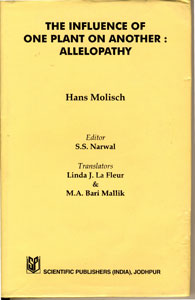 THE
INFLUENCE OF ONE PLANT ON ANOTHER: ALLELOPATHY. [Translated from German (Published
1937)]
THE
INFLUENCE OF ONE PLANT ON ANOTHER: ALLELOPATHY. [Translated from German (Published
1937)]

Hans Molisch, Institute of Plant Physiology, University of Vienna, Vienna,
Austria
Editors: S. S. Narwal, Department of Agronomy, Haryana Agricultural University,
Hisar-125 004, India
M.A.B. Mallik, Agricultural Programme, Langston University, Langston, OK,
USA.
Translator: L. J. Lafleur, Department of English, Oklahoma State University,
Stillwater, OK, USA.
This is the first rare and classic book on Allelopathy (published 1937) in German
language. It provides the background about the birth of Science of Allelopathy,
the scientific explanation of this phenomenon, hitherto known only to few people
knowing German language. This book was out of print since last many years. Presently
allelopathy research is being done in most countries of the World, but majority
of these scientists could not read this book due to its German language. Hence,
English speaking scientists could not make use of the allelopathic principles and
findings explained in this book. Therefore, the main aims of the translation were:
I) to provide an opportunity for current allelopathy scientists Worldwide to read
Molisch's early classic research, II) to derive inspiration from it, III) to take
cues from the methodologies used for improving the ongoing research and IV) to utilize
its principles in their current research programmes.
This book reviews the old research findings (before 1930) in the fields related
to allelopathy. Prof. Molisch for the first time, studied the effects of numerous
plants spp. and their plant parts viz., roots, shoots, leaves, flowers, fruits on
the seed germination, seedling growth and maturity of fruits in several plant spp.
The methodology followed and the salient findings of more than 100 laboratory, greenhouse
studies have been described through Photographs and Tables. Besides, the book also
narrates the story behind the nomenclature of term "Allelopathy".
CONTENTS
1. Introduction and historical background, 2. Influence of fruits on growth and
other processes, 3. Own experiments, 4. Role of Inhibitory substances in plant kingdom,
5. Germination stimulatory/inhibitory substances, 6. Major findings, 7. Literature,
8. Subject index, 9. Appendices.
This book will be indispensable for the allelopathy scientists and graduate students
in agriculture (agronomists, entomologists, nematologists, plant pathologists, horticulturists,
plant breeders, agroforesters, soil scientists) and biosciences (plant ecologists,
biochemists, organic chemists, microbiologists and limnologists).
May 2001: 225 x 150 mm; XX + 134 pp.; 26 Tables; 15 Figures; Hard Back: Euro 25.00.
ISBN: 81-7223-285-8
Price: Euro 25.00,

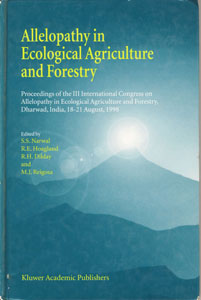 ALLELOPATHY
IN ECOLOGICAL AGRICULTURE AND FORESTRY (Proceedings, III International Congress
on Allelopathy in Ecological Agriculture and Forestry)
ALLELOPATHY
IN ECOLOGICAL AGRICULTURE AND FORESTRY (Proceedings, III International Congress
on Allelopathy in Ecological Agriculture and Forestry)

Editors: S.S. Narwal, Department of Agronomy, Haryana Agricultural University,
Hisar-125 004, India
Robert E. Hoagland, USDA-ARS, Southern Weed Science Lab., Stoneville, MS,
USA
R. H. Dilday, USDA-ARS, National Rice Germplasm Centre, Stuttgart, AR, USA
Manuel J. Reigosa, Faculty of Science, University of Vigo, Vigo, Spain
The rapidly growing human population has increased the dependence on fossil fuel
based agrochemicals, such as fertilizers and pesticides, to produce the required
agricultural and forestry products. This has exerted a great pressure on the non-renewable
fossil fuel resources, which cannot last indefinitely. Agrochemicals not only pollute
the environment, but also the pests become resistant to pesticides. Thus the present
agricultural practices are exploitive of natural resources and are damaging the
fauna, flora and agroecosystems. One safe alternative to overcome these problems
is the use of allelopathy to sustain development in ecological agriculture and forestry
and maintain a clean environment for our future generations.
This book is the Proceedings of the III International Congress, Allelopathy in Ecological
Agriculture and Forestry, held on August 18-21, 1998 at the University of
Agricultural Sciences, Dharwad, Karnataka, India. It provides an updated status
of current allelopathy research in various leading countries, with the overall aim
to develop new technologies for ecological agriculture and forestry in the 21st
century. To date, no book on ecological agriculture has discussed these aspects,
hence, it is the first time that such information is available. The chapter contributors
are leaders in their fields and all chapters have been peer reviewed by international
referees.
CONTENTS
Section I. Ecological agriculture. 1. Allelopathy in ecological agriculture;
S.S. Narwal, 2. Allelopathic strategies for Eco-friendly crop production; S. Facknath
and B. Lalljee, 3. Allelopathic interactions in soil; B. Lalljee and S. Facknath,
4. Eco-friendly technologies for management of phytotoxic nematodes in pulses and
vegetable crops; V. Mojumder.
Section II. Allelochemicals as herbicides. 5. Plant and microbial compounds
as herbicides; Robert, E. Hoagland; Stephen J. Cutler, 6. Discovery of the triketone
class of HPPD inhibiting herbicides and their relationship to naturally occurring
B- triketones; Christopher G. Knudsen el al., 7. Phytotoxins as potential herbicides;
F. Sugawara, 8. Evaluation of selected pharmaceuticals as potential herbicides;
bridging the gap between agrochemicals and pharmaceuticals; Stephen J. Culler, Robert
E. Hoagland and Horace G. Culler.
Section III. Multiple Cropping Systems. 9. Allelopathic interactions in multiple
cropping systems; S.S. Narwal, 10. Prospects of allelopathic research in multi-storey
cropping systems; Jacob John and A.M Nair.
Section IV. Agroforestry systems. 11. Allelopathic interactions in forests;
M.J. Reigosa, L. Gonzalez, X.C. Souto and E. Pastoriza, 12. Allelopathic interactions
in agroforestry systems; A.S. Gill and J.V.N.S. Prasad, 13. Allelopathic research
in agroforestry systems of South India; C.S. Hunshal, H.T Channal, A.R. Alagalwadi
and R.H. Patil, 14. Tree allelopathy in agroforestry; M. Parmathama, J.A. Amal and
M. Rajkumar, 15. Toxic aIlelochemicals in leguminous forages and their ecological
significance; S.S. Parihar, Section V. Appendices etc.
This book will be very useful for allelopathy scientists and graduate students in
agriculture (agronomists, entomologists, nematologists, plant pathologists, horticulturists,
plant breeders, agroforesters, foresters, soil scientists), biosciences (plant ecologists,
biochemists, organic chemists, microbiologists and limnologists), environmentalists
and farmers, as well as organizations engaged in sustainable agriculture and organic
agriculture.
August 2000: 245 x 150 mm; XII + 268 pp.; 32 Chemical structures; 43 Tables; 9 Figures;
Hard Back: Euro 100.00. ISBN: 0-7923-6348-5. Not Available.
Price: Euro 100.00,

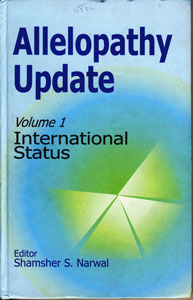 ALLELOPATHY
UPDATE VOLUME 1. INTERNATIONAL STATUS
ALLELOPATHY
UPDATE VOLUME 1. INTERNATIONAL STATUS

Editor: S.S. Narwal, Department of Agronomy, Haryana Agricultural University,
Hisar-125 004, India.
The term allelopathy was coined by Molisch in 1937 and includes both inhibitory
and stimulatory effects of plants on each other including microorganisms. Most of
the research in this field has been conducted in developed countries during the
last 30- 40 years. The first Book on Allelopathy written by Dr. E.L. Rice was published
in 1974 and thereafter, many Books have appeared on its various aspects but none
deal with the current status of research. Besides, during this period, thousands
of research papers on various aspects of allelopathy have been published. This indicates
the great interest World over in this new discipline because of its importance in
modern sustainable agriculture. However till now, no book is available about the
National status of allelopathy research in various countries, therefore, this book
has been published.
This volume contains information about the country-wise status of allelopathy research
to provide an over view of research already done. It would be valuable to academicians
and researchers and aims (a) to improve the class room teaching, (b) to provide
a comprehensive update of allelopathy research Worldwide, (c) to serve as bench
mark for conducting advanced research and (d) to avoid repetition of research; thereby
saving valuable time, energy and money resources of scientists. The book provides
update status of allelopathy research in 18 leading Countries of the World.
CONTENTS
Section I. European Status of Research: 1. Research on Allelopathy in Czech
Republic; M Vicherkova, F. Phlak and I. Kousalova, 2. Research on Allelopathy in
Greece; K.L. Kalburtji, 3. Research on Allelopathy in Hungary; G. Kazinczi, 4. Research
on Allelopathy in Italy; G. Aliotta and G. Cafiero, 5. Research on Allelopathy in
Poland; D. W. Wojtkowiak. W. W. Kaczmarkova and B. Politycka, 6. Research on Allelopathy
in Portugal; L.S. Dias, I.P. Pereira and A.S. Dias, 7. Research on Allelopathy in
Spain; M.J Reigosa, L. Gonzalez and X.C. Souto, 8. Allelopathy Research in Fonner
Soviet Union; V. V. Roshchina and V.D. Roshchina.
Section II. Asian Status of Research: 9. Research on Allelopathy in India;
S.S. Narwal, 10. Research on Allelopathy in Iraq; I.S. Alsaadawi, 11. Research on
Allelopathy in Japan; J. Mizutani and Y. Fujii, 12. Research on Allelopathy in Jordan;
J.R. Qasem, 13. Research on Allelopathy in Korea; B.S. Kil, 14. Research on Allelopathy
in Mauritius; S. Facknath and B. Lalljee, 15. Research on Allelopathy in Philippines;
JR. Pardles, Jr. and R.M Y. Dutin.
Section III. South American Status of Research: 16. Research on allelopathy
in Brazil; B.N. Rodrigues, T Pasini and A.G. Ferreira, 17. Allelopathy Research
in Costa Rica; E.A. Fonesca and UB. Cartin.
This publication will be necessary for the allelopathy scientists and graduate students
in agriculture (agronomists, entomologists, nematologists, plant pathologists, horticulturists,
plant breeders, agroforesters, soil scientists) and biosciences (plant ecologists,
biochemists, organic chemists, microbiologists and limnologists).
September 1999: 245 x 160 mm; XII+338 pp.; 13 Chemical structures; 73 Tables; 67
Figures; Hard Back: Euro 50.00. ISBN: 1-57808-064-9 (Vol. I). Not Available.
Price: Euro 50.00,

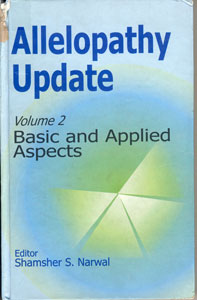 AILELOPATHY
UPDATE VOLUME 2. BASIC AND APPLIED ASPECTS
AILELOPATHY
UPDATE VOLUME 2. BASIC AND APPLIED ASPECTS

Editor: S.S. Narwal, Department of Agronomy, Haryana Agricultural University,
Hisar-125 004, India
Allelopathy offers great potential to (a) increase agricultural production (food
grains, vegetables, fruits, forestry), (b) to decrease harmful effects of modern
agricultural practices [multiple cropping, leaching losses from N fertilizers, indiscriminate
use of pesticides (weedicides, fungicides, insecticides, nematicides), tolerant/resistant
biotypes in pest] on soil health/ productivity and on environment and (c) to maintain
soil productivity and a pollution free environment for our future generations. In
the near future, allelopathy may be used in crop production, crop protection, agroforestry
and agrohorticultural practices in developed and developing countries. Allelopathy
may become one of the strategic sciences to reduce the environmental pollution and
to increase agricultural production in Sustainable Agriculture of the 21st Century.
Thus, it is now receiving more attention from agricultural and bioscientists.
Most of the allelopathic research has been conducted on basic aspects. The research
on applied aspects is gaining attention since 1980's mainly in Agricultural Institutes.
Now much information is available on both Basic and Applied aspects of Allelopathy,
but no Book provides complete information regarding the current status of allelopathy
research at the International level. Allelopathy scientists interested in knowing
this, have to consult several Books etc. Although such information may be available
to the Western World through electronic media, but this facility will not be available
to thousands of allelopathy scientists in the under developed countries, where the
importance of allelopathy is greater.
This volume contains updated information on various basic, applied and pests control
aspects of allelopathy, for pests management with minimum use of present pesticides
(weedicides, insecticides, nematicides and fungicides), to reduce environmental
pollution and to improve productivity for sustainability of agriculture and forestry.
This Book aims (a) to provide a comprehensive update of allelopathy research Worldwide,
(b) to serve as a bench mark for planning of future research, (c) to act as reference
Book for the students, (d) to prevent repetition type of research in different parts
of the World, (e) to improve agricultural production through use of allelopathic
strategies and (f) to reduce environmental pollution by minimising the use of presents
pesticides. More than 22 scientists from different countries have contributed 16
Chapters to the Book.
CONTENTS
Section I. Basic and Applied Aspects. 1. Mechanisms of cell-cell communication;
V. V Roshchina, 2. Plant ecochemicals in allelopathy; J.Mizutani, 3. Essential oils
as allelochemicals: Research advances in Greece; D. Vokou, 4. Glucosinolate-derived
allelochemicals in the soil environment; P.D. Brown and M.J. Morra, 5. Allelopathy
in the grassland ecosystems; A.E. Smith, 6. Allelochemicals in maize resistant to
Spodoptera frugiperda and Helicoverpa zea; B.R. Wiseman, M.E. Snook, J.E. Carpenter
and K.E. Espelie, 7. Allelopathic potential of Eucalyptus spp.; P.L.C.A. Alves,
R.E.B. Toledo and A.B. Gusman, 8. Autotoxic potential of vegetable crops; J. Q.
Yu, 9. Allelopathy in desert ecosystems: An overview, problems and prospects; A.K.
Hegazy, 10. Allelopathy and nitrogen fixation in legumes; M.A.B. Mallik.
Section II. Weed Management. 11. Allelopathy in weed management; S.S. Narwal,
12. Weed control with Brassica green manure crops; K. AI-Khatib and R. Boydston,
13. Allelopathic crops for weed management in cropping systems; N. Semidey.
Section III. Insect Management. 14. Plant allelochemicals in aphids management;
B. Leszczynski, 15. Is there a role for pollen allelopathy in biological control
of weeds? S.D. Murphy.
Section IV. Disease Management. 16. Allelopathic control of soil-borne diseases
in vegetable crops; J.Q. Yu.
This publication will be very useful to the allelopathy scientists and graduate
students in agriculture (agronomists, entomologists, nematologists, plant pathologists,
horticulturists, plant breeders, agroforesters, soil scientists) biosciences (plant
ecologists, biochemists, organic chemists, microbiologists and limnologists), crop
production and crop protection.
September 1999: 245 x 160 mm; XIV + 350 pp.; 7 Chemical structures; 65 Tables; 45
Figures; Hard Back: Euro 50.00. ISBN: 1-57808-065-7 (Vol. 2), 1-57808-063-0 (Set).
Not Available.
Price: Euro 50.00,

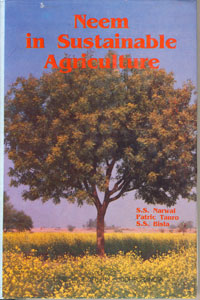 NEEM
IN SUSTAINABLE AGRICULTURE
NEEM
IN SUSTAINABLE AGRICULTURE

Editors: S. S. Narwal, Department of Agronomy, Haryana Agricultural University,
Hisar-125 004, India
Patrick Tauro, Haryana Agricultural University, Hisar- 125 004, India
S.S. Bisla, Department of Forestry, Haryana Agricultural University, Hisar-125004,
India
Neem is a versatile tree of Indian origin. Since ancient times, its various plant
parts have been used to control domestic insects, stored grain pests, crop pests
and as human and livestock medicine. Recently, these properties have been attributed
to hundreds of chemicals present in this Golden tree. Being a storehouse of chemicals,
with multiple uses and adaptability to diverse habitats and climatic conditions,
the developed countries have shown keen interest in this tree. Besides, the present
day pesticides and nitrogen fertilizers pose several problems viz., environmental
pollution and related health hazards in human and livestock, development of resistance
in organisms to pesticides and death of beneficial insects. While neem chemicals
have shown potential as pesticides and as nitrification inhibitors and do not pose
these problems; moreover, neem cake is used as manure. Therefore, keeping in view
the importance of this tree, a session of Neem in Current Context was held at the
International Symposium on Allelopathy in Sustainable Agriculture, Forestry and Environment,
New Delhi during September 6-8, 1994. There were 20 presentations on neem, during
this Conference. It was decided to prepare a separate book on neem based on the
updated world literature from the presentations made at the symposium as well as
a few others, from well known neem researchers.
In the recent past, many books have been published on neem, but this book is unique
in following ways: (a) it deals with improving production technology of this wonder
tree, (b) it provides current status of neem research in production of agricultural
and horticultural crops and (c) the book outlines Recommendations on the use of
neem and its products in crop production and plant protection
CONTENTS
1. Botany; C.M. Ketkar and M.S. Ketkar, 2. Genetic improvement; S.S. Bisla and V.
Beniwal, 3. Tree management; D.P.S. Nandal and R. Bahadur, 4. Agroforestry; A. S.
Gill, 5. Fertilizer management; S.S. Narwal and T. Singh, 6.Tobacco research; M.S.
Chari, G. Ramaprasad, P.S.N. Murthy and S.S. Sitaramiah, 7. Groundnut research;
M.P. Ghewande, V. Nandgopal and S. Desai, 8. Black pepper research; S. Devasahayam
and M. Anandraj, 9. Insects pest management of agricultural crops; A.K. Dhawan and
G.S. Dhaliwal, 10. Stored grains insects pest management; H. Singh, V. Kumar, R.
Kumar and H.R. Rohilla, 11. Nematode management; V. Mozumder, 12. Plant diseases
management; R.S. Singh and H.V. Singh, 13. Pulses pests management; R.P. Yadava,
B. Singh, M.G. Heider, B.K. Sinha, 14. Oilseeds pests management; V. Kumar, H. Singh
and R. Kumar, 15. Cotton pests management; A.K. Dhawan and G.S. Dhaliwal, 16. Nematode
management in horticulture crops; P.P. Reddy, M.S. Rao and M. Nagesh, 17. Ginger
diseases management; N.P. Dohroo and N. Pathania, 18. Industrial uses and commercialization;
B.S. Parmar.
This book will be essential to neem scientists working in life sciences, agriculture
and forestry and to environmental conscious farmers of developed countries and to
the educated farmers of Third World countries intending to Practice Sustainable
Agriculture.
August 1997 : 225 x 150 mm; XII + 266 pp.; 47 Tables; Hard Back: Euro 40.00. ISBN:
81-7223-167-3.
Price: Euro 40.00,

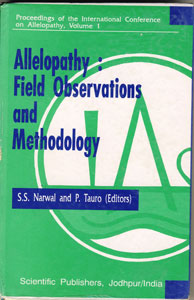 ALLELOPATHY:
FIELD OBSERVATIONS AND METHODOLOGY (Proceedings, International Conference on Allelopathy.
Volume I)
ALLELOPATHY:
FIELD OBSERVATIONS AND METHODOLOGY (Proceedings, International Conference on Allelopathy.
Volume I)

Editors: S. S. Narwal, Department of Agronomy, Haryana Agricultural University,
Hisar-I25 004, India
Patrick Tauro, Haryana Agricultural University, Hisar- I25 004, India
Sustainable Agriculture aims at long term maintenance of natural resources and agricultural
productivity with minimal adverse impact on environment. It emphasizes the optimal
crop production with minimal dependence on agrochemicals (fertilizers, pesticides)
and substituting them with sustainable allelopathic strategies, which could maintain
the productivity over long periods. Thus for future sustainability, crop production
must minimise use of agrochemicals and use allelopathy and other practices. As allelopathy
is new field of science, hence, its research methodology is scantily available.
Therefore, during the International Conference on Allelopathy in Sustainable Agriculture,
Forestry and Environment in 1994 at New Delhi, India one session was devoted
each to Field Observations and Methodology of Allelopathy. In these sessions, 81
presentations were made, of these 22 have been included in this book. These Chapters
from the eminent scientists and Proceedings of the Conference provides upto date
information.
CONTENTS
Section I. Field Observations. 1. Allelopathy related problems in crop production,
agroforestry and agrihorticulture; S.S. Narwal, 2. Allelopathy in Eucalyptus: Australian
studies; R.J. Willis, 3. Allelopathy from ecosystem to cell in spruce (Picea abies)
forests; F. Pellissier, 4. Allelopathy in horticultural crops; D. Leela and S. Mohandas,
5. Allelopathy in aquatic ecosystems; U. Goel, 6. Allelopathic interactions between
some weeds and crops: The South African experience; C.F. Reinhardt and R. Meisner,
7. Allelopathy in agroforestry systems; A.S. Gill and S.S. Parihar.
Scction II. Methodology. 8. Whither allelopathy? P. Tauro, 9. Chemical analysis
of allelopathic compounds; G.R. Waller and M.C. Feng, 10. Allelopathic research:
Methodological, ecological and evolutionary aspects; M. J. Reigosa, X. C. Souto
and L. Gonzalez, 11. Plant excretions as natural antiozonants and origin of free
radicals: Theoretical approach; V. V. Roshchina, 12. Potential allelochemicals from
aquatic weeds: Their action on microalgae; G. Aliotta, M. Della Greca, P. Monaco,
G. Pinto, A. Pollio and L. Previtera, 13. Suggested methodology for allelopathy
laboratory bioassays; S.S. Narwal.
Section III. Contributory papers. 14. Allelopathic potential of C3 and C4
weeds on seedling vigour of wheat (Triticum durum Desf.); D.S. Uppar, A.S. Nalini,
M.B. Chetti and S.M. Hiremath, 15. Allelopathic effects of Cyperus weeds on germination
and growth of rice; R.A. Raju and M.N. Reddy, 16. Stimulatory effect of Lantana
camara on fingermillet; S.R. Ambika and B. Vidya, 17. Effect of various plants leaf
leachates on the germination and seedling growth of Parthenium hysterophorus L.,
S. Sankaran, O.S. Kandasamy, C. Loganathan and N. Balasubrahmaniam, 18. Bioassay
studies with allelochemicals from the bark of Prunus cornuta; C.B. Pande, M.C. Purohit,
M.S.M Rawat and G. Pant, 19. Effect of Eucalyptus leaves and bark extracts on germination
and growth of mustard; S.S. Yadava, D.P.S. Nandal, M.S. Hooda and R. Bahadur, 20.
Phytotoxic effects of tree crops on germination and radicle extension of legumes;
G. Velu, P.S. Srinivasan and A.M. Ali, 21. Allelopathic interactions of tree species
with crops; R.C. Uniyal and A.R. Nautiyal, 22. Screening of Bauhinia spp. for fungicidal,
bactericidal and insecticidal properties; A.G. Hajra and P. Chatterjee.
This book will be vital to allelopathy scientists and postgraduate students of agriculture,
forestry and biosciences for improving their allelopathic research.
July 1996: 225 x 150 mm; XXX + 342pp.; 13 Chemical structures; 47 Tables; 57 Figures;
Hard Back: Euro 40.00. ISBN: 81-7223-130-4 (Vol. I).
Price: Euro 40.00,

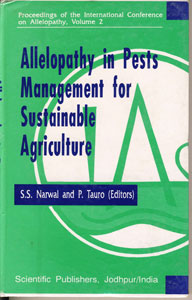 ALLELOPATHY
IN PEST MANAGEMENT FOR SUSTAINABLE AGRICULTURE (Proceedings, International Conference
on Allelopathy. Volume 2.)
ALLELOPATHY
IN PEST MANAGEMENT FOR SUSTAINABLE AGRICULTURE (Proceedings, International Conference
on Allelopathy. Volume 2.)

Editors: S. S. Narwal, Department of Agronomy, CCS Haryana Agricultural University,
Hisar-125 004, India
Patrick Tauro, Haryana Agricultural University, Hisar- 125 004, India
Indiscriminate use of pesticides for pest (insects, nematodes, pathogens, weeds)
control has resulted in serious ecological and environmental problems viz., (a)
increasing development of resistance in organisms to pesticides, (b) shifts in pests
species, the minor pests have become dominant and their control needs higher doses
of most toxic pesticides, (c) greater environmental pollution and (d) toxic residues
of pesticides in agricultural commodities cause serious health hazards in human
and livestock. Therefore, serious ecological questions about the reliance on pesticides
for pest control have been raised World-wide. Crops are being grown since ancient
times without damage to the environment but the indiscriminate use of pesticides
during the short span of last 50 years have raised serious doubts about their continuous
use. Studies have shown that allelopathic strategies and allelochemicals may help
in pest control, besides, these are free from problems associated with present herbicides.
That is why, it is important area of research in most countries of the World.
In view of great importance of allelopathy in future pest management strategies,
Indian Society of Allelopathy, Hisar, India organised an International Conference
on allelopathy in Sustainable Agriculture, Forestry and Environment in 1994,
at New Delhi. Out of the six technical sessions of the Conference, one was devoted
to Allelopathy in Pest Management in which 47 presentations were made. This book
is proceedings of the conference, thus contains seventeen chapters by eminent scientists
and provides upto date information.
CONTENTS
Section I. Invited Papers. 1. Brassicacae as alternative plants for weed
control in sustainable agriculture; W. Oleszek, J. Ascard and H. Johansson, 2. Potentials
and prospects of allelopathy mediated weed control for sustainable agriculture;
S.S. Narwal, 3. Management of parthenium through allelopathic interactions; M. Mahadeveppa
and R.S. Kulkarni, 4. Field crops as source of natural herbicide models: Sunflower;
F.A. Macias, A. Torress and J.M.G. Molinillo, 5. Botanical pesticides in insect
pest management: Emerging trends and future strategies; G. S. Dhaliwal. R. Arora
and V. K. Dilawari, 6. Insectistatic role of plant aIlelochemicals in pest management;
R. N. Sharma, 7. Medicinal and aromatic plants in insect pest management; D. Singh,
8. Allelochemicals from fungal fermentation: Some research applications; H. G..
Cutler and S.R. Parker, 9. Allelopathy in nematode management; R.K Walia and D.S.
Bhatti.
Section II. Contributory Papers. 10. Effects of Eucalyptus leaf leachates
and oil on growth of Cyperus rotundus and Cynodon dactylon; R.C. Babu et al, 11.
Juvenile hormone activity of some plant oils against mustard aphid (Lipaphis erysimi);
G. Singh and P.S. Kalsi, 12. Studies on Helicoverpa armigera resistance in relation
to allelochemicals in cotton; B. Rosaiah, A.S. Reddy and Y. N. Rao, 13. Pod borer
resistance in relation to chemical constituents in chilli; S.V. Rao, 14. Comparative
bioefficacy of neemark (Azadirachtin) and conventional insecticides against mango
thrips (Scirtothrips dorsalis); S. Kumar, C. B. Patel, A.B. Rai and R.I. Bhatt,
15. Evaluation of neem insecticides against the cardamom thrips (Scirtothrips cardamomi);
B. Gopakumar and J. Singh, 16. Bioefficacy of Azadirachtin (Neem) based formulation
against castor semilooper (Achaea janata); D.B. Jyani,T.M. Bharpoda and J.R. Patel,
17. Efficacy of oilseed cakes, crop straws and saw dust against seedling blight
of Eucalyptus; J.C. Kaushik, V.G.K. Gupta and N. Kaushik.
This publication will be very useful to the allelopathy scientists and graduate
students in agriculture (agronomists, entomologists, nematologists, plant pathologists,
horticulturists, plant breeders, agroforesters, soil scientists), biosciences (plant
ecologists, biochemists, organic chemists, microbiologists and limnologists), crop
production and crop protection.
July 1996: 225 x 150 mm; XII + 236 pp.; 10 Chemical structures; 24 Tables; 6 Figures;
Hard Back: Euro 40.00. ISBN: 81-7223-131-2 (Vol. 2), 81-7223-132-0 (Set).
Price: Euro 40.00,

ALLELOPATHY IN AGRICULTURE AND FORESTRY
Editors: Shamsher S. Narwal, Department of Agronomy, Haryana Agricultural
University, Hisar-125 004, India
Patrick Tauro, Haryana Agricultural University, Hisar- 125 004, India
The allelopathy research in the early years was mainly done in field crops. Later
on it was observed that trees also influence the plant density, growth and development
of plant spp. growing under its canopy and even outside the tree canopy. Therefore,
allelopathy research in forestry started much later after 1970, now it is current
area of research in developed countries. Till now not much information is available
about the allelopathic interactions in agroforestry systems, which is major practice
is tropics and subtropics. It is likely that allelopathic research in forestry and
agroforestry may help in overcoming several problems related to allelopathy and
thus increasing their productivity.
Now some information is available on both Allelopathy in Agriculture and Forestry,
but there is no book which provides complete information in this regard. Allelopathy
scientists interested in knowing these aspects, have to consult several books etc.
Although such information may be available to the western World through electronic
media, but this facility will not be available to thousands of allelopathy scientists
in the under developed countries, where the importance of allelopathy is greater.
In view of this, the present book has been published to provide an insight into
the allelopathic interactions and problems in Agriculture and Forestry ecosystems,
in different countries.
This book is Proceedings of First National Symposium Allelopathy in Agroecosystems
(Agriculture and Forestry) organised from February 12-14, 1992 at Haryana
Agricultural University, Hisar, India. This was the first Conference on allelopathy
in Asia. The eminent speakers delivered sixteen invited lectures in four technical
sessions: (I) Crop Production, (II) Forestry and Grassland, (III) Aquatic-ecosystems
and (IV) Allelochemicals. The chapters provide updated information on basic
and applied aspects of allelopathy in the fields of agriculture and forestry and
outlines future goals of research. Questions and answers asked during the lectures
have been added chapter-wise. Besides, proceedings of the Conference and list of
participants has also been included.
CONTENTS
1. Overview of allelopathy; E.L. Rice, 2. The Science of allelopathy: Problems and
prospects; G.L. Bansal, 3. Allelopathic problems in Indian agriculture and prospects
of research; S.S. Narwal, 4. Role of allelopathy in crop weed interactions: Priority
and prospects; S.M. Pandya, 5. Allelopathic implications of Eucalyptus in agroecosystems;
R.K. Kohli, 6. Allelopathic interactions in agroforestry systems; D.P.S. Nandal,
S.S. Bisla, S.S. Narwal and J.C. Kaushik, 7. Allelopathy research in forest ecosystems
of Slovakia; V. Caboun, 8. Allelopathy in fruit crops; S. Sharma, S.D. Chitkara
and R.S. Daulta, 9. Ecological significance of allelochemicals: Occurrence of canavanine
in Medicago sativa L.; J. Miersch, D. Schlee and I. Rosche 10. Allelochemicals:
Their potential in pest management; G.S. Dhaliwal and J.S. Bhathal, 11. Control
of plant parasitic nematodes by plant substances; N.C. Sukul, 12. Allelochemicals
in medicinal and aromatic plants; C.S. Mathela, 13. Botanicals in allelopathic march:
Current view and the thrust for future; S.N. Tewari, 14. Allelopathy: Future role
in weed control; S.S. Narwal, 15. Chemosensory mechanisms in allelopathy V. V. Roshchina,
16. Recommendations of the symposium.
September 1994: 225 x 150 mm; XII + 310 pp.; 4 Chemical structures; 48 Tables; 23
Figures; Hard Back: Euro 40.00. ISBN: 81-7223-085-5.
Price: Euro 40.00,

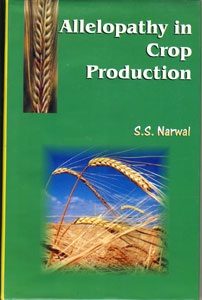 ALLELOPATHY
IN CROP PRODUCTION
ALLELOPATHY
IN CROP PRODUCTION

S. S. Narwal, Department of Agronomy, Haryana Agricultural University, Hisar-125
004, India
The term allelopathy was coined by Molisch in 1937 and includes both inhibitory
and stimulatory effects of plants on each other including microorganisms. Most of
the research in this field has been conducted in developed countries during the
last 30-40 years. The first Book on Allelopathy written by Dr. E.L. Rice was published
in 1974 and thereafter, many Books have appeared on its various aspects but none
deal with the crop production aspects. Besides, during this period, thousands of
research papers on various aspects of allelopathy have been published. This indicates
the great interest World over in this new discipline because of its importance in
modern sustainable agriculture. However, till now no book addresses the allelopathic
interactions involved and role of allelopathy in field Crops Production. Allelopathy
scientists interested in knowing these aspects, have to consult several Books etc.
Although such information may be available to the Western World through electronic
media, but this facility will not be available to thousands of allelopathy scientists
in the under developed countries, where the importance of allelopathy is greater.
In view of this, the present book has been published. This book is based on the
research findings and addresses to various complex problems of crop production,
to which there was no definite answer in the past but now these have been attributed
to allelopathy.
CONTENTS
I. Introduction, 2. Allelochemicals, 3. Interactions between plant communities,
4. Exploitation of allelopathy for crop production, 5. Removal of phytotoxin from
agricultural lands, 6. Future prospects, 7. Glossary of crops and weeds.
This book will be indispensable for the allelopathy scientist and graduate students
in agriculture (agronomists, entomologists, nematologists, plant pathologists, horticulturists,
plant breeders, agroforesters, soil scientists) and biosciences (plant ecologists,
biochemists, organic chemists, microbiologists and limnologists). It may also serve
as text book to the agriculture students.
September 1994: 225 x 150 mm; XII + 304 pp.; 77 Tables; 16 Figures; Hard Baek: US$
40.00. ISBN: 81-7223-085-5.
Price: Euro 40.00,

ALLELOPATHY IN SUSTAINABLE TERRESTRIAL AND AQUATIC ECOSYSTEM Abstracts, IV. International
Congress ( 2004).
Editors: S. S. Narwal, International Allelopthy Foundation, CCS Haryana Agricultural
University, Hisar-125 004, India
Barbara Polyticka, Department of Botany, Agricultural University, Wolynska
35, 60-637, Poznan, Poland
It has been established that allelopathy offers great potential (a) to increase
agricultural production (food grains, vegetables, fruits, forestry), (b) to decrease
harmful affects of modern agricultural practices [multiple cropping, leaching losses
from N fertilizers, indiscriminate use of pesticides (weedicides, fungicides, insecticides,
nematicides), tolerant/resistant biotypes in pest] on soil health/productivity and
on environment and (c) to maintain soil productivity and a pollution free environment
for our future generations. It is likely that in the near future allelopathy will
be used in crop production, crop protection, agroforestry and agrohorticiltural
practices in developed and developing countries. Allelopathy may become one of the
strategic sciences to reduce the environmental pollution and to increase agricultural
production in Sustainable Agriculture of the 21st Century. Thus, it is now receiving
more attention from Agricultural and Bioscientists.
The International Allelopathy Foundation organised the IV. International
Allelopathy Congress, Allelopathy in sustainable Terrestrial and Aquatic Ecosystems
from August 23-25, 2004 at Haryana Agricultural University, Hisar, Haryana, India.
The Conference aimed to bring together active allelopathy scientists from worldwide
to review progress, identify constraints, project future goals for basic and applied
allelopathy research in Terrestrial and Aquatic Ecosystems. The outstanding International
Allelopathy Scientists from Poland, Slovakia, Romania, Japan, China, Pakistan and
Iran participated in this conference. The nine Technical Symposia comprised of (i).
Soil Sickness, (ii). Weed Management, (iii). Cropping System, (iv). General, (v).
Forestry/Agroforestry/Horticulture, (vi). Allelopathic Plants, (vii). Insect Management,
(viii). Nematode/Pathogen Management and (ix). Methodology. A total of 128
presentations (Key Note, Plenary, Invited Lectures and Posters) were made by 102
delegates from 8 countries. Prof. Barbara Politycka, Poland, the most eminent Allelopathy
Scientist was the Chief Guest at the congress. This publication contains all the
abstracts presented at this conference and highlights the various aspects of current
allelopathic research in different parts of the World.
This book will be vital for the allelopathy scientists and graduate students in
Agriculture (Agronomists, Entomologists, Nematologists, Plant Pathologists, Horticulturists,
Plant Breeders, Agroforesters, Soil Scientists) and Biosciences (Plant Ecologists,
Biochemists, Organic Chemists, Microbiologists and Limnologists). Besides, it will
be also useful for the environmentalists and intelligent farmers.
August 2004: 240 x 180 mm, 130 pp. 280 g. Paper Back: Euro 20.00.
Price: Euro 20.00,

 ALLELOPATHY
IN ECOLOGICAL AGRICULTURE AND FORESTRY Abstracts, III International Congress. (
1998).
ALLELOPATHY
IN ECOLOGICAL AGRICULTURE AND FORESTRY Abstracts, III International Congress. (
1998).

Editors: S. S. Narwal, Department of Agronomy, Haryana Agricultural University,
Hisar-125 004, India
Robert E. Hoagland, USDA-ARS, Southern Weed Science Lab., Stoneville, MS,
USA
Robert H. Dilday, USDA-ARS, National Rice Germplasm Centre Stugart, AR. USA
Manuel J. Reigosa, Faculty of Science, University of Vigo, Vigo, Spain
The rapidly growing human population has increased the dependence on fossil fuel
based agrochemicals such as fertilizers and pesticides to produce the required agricultural
and forestry products. This has exerted a great pressure on the non-renewable fossil
fuel resources, which cannot last indefinitely. Besides, agrochemicals pollute the
environment, the pest develop tolerance to pesticides and their new resistant strains
are emerging. Hence, such practices cannot remain in use for ever. One safe alternative
to overcome these problems is, the use of allelopathy to sustain development in
agriculture and forestry and maintenance of clean environment for our future generations.
The Indian Society of Allelopathy held the Third International Congress Allelopathy
in Ecological Agriculture and Forestry from August 18-21, 1998, at the University
of Agricultural Sciences, Dharwad, Karnataka, India. The Congress was aimed at bringing
together active allelopathy scientists all over the world, to review the progress,
identify constraints and plan for the next millennium, so as to provide a momentum
to the applied aspects of allelopathy research in agriculture and forestry to maintain
clean environment. The six technical symposia comprised of (I) Crop Allelopathy,
(II) Cropping Systems, (III) Agroforestry, (IV) Allelochemicals as Herbicides, (V)
Plant Protection and (VI) Ecological Agriculture. A total of 128 presentations
(Key note, Plenary, Invited lectures, Contributory papers and Posters) were made
by 106 delegates from 18 countries. Prof. R.H. Dilday, USA, the Father of Rice Allelopathy,
was the Chief Guest at the Congress. This publication contains all the abstracts
presented at this conference and highlights the various aspects of current allelopathic
research in different parts of the World.
This book will be vital for the allelopathy scientists and graduate students in
agriculture (agronomists, entomologists, nematologists, plant pathologists, horticulturists,
plant breeders, agroforesters, soil scientists) and biosciences (plant ecologists,
biochemists, organic chemists, microbiologists and limnologists). Besides, it will
be also useful for the environmentalists and intelligent farmers.
August 1998: 240 x 180 mm; 164 pp.; 350 g. Paper Back: Euro 20.00.
Price: Euro 20.00,

ALLELOPATHY IN SUSTAINABLE AGRICULTURE, FORESTRY AND ENVIRONMENT Abstracts, International
Symposium, September 6-8, 1994.
Editors: Shamsher S. Narwal, Department of Agronomy, Haryana Agricultural
University, Hisar-125 004. India
Patrick Tauro, Haryana Agricultural University, Hisar-125 004, India
In the last few decades, the rapidly growing human population has increased the
dependence on fossil fuel based agrochemicals such as fertilizers and pesticides
to produce the required agricultural and forestry products. This has exerted a great
pressure on the non-renewable fossil fuel resources, which cannot last indefinitely.
Besides, agrochemicals pollute the environment, the pests develop tolerance to pesticides
and their new resistant strains are emerging. Hence, such practices cannot remain
in use forever. One safe alternative to overcome these problems is, the use of allelopathy
to sustain development in agriculture and forestry and to maintain clean environment
for our future generations. The Indian society of Allelopathy held the Second in
series the International Symposium Allelopathy in Sustainable Agriculture, Forestry
and Environment from September 6-8, 1994 at the Indian Agricultural Research
Institute, New Delhi, India. The symposium was aimed at bringing together active
allelopathy scientists all over world, to review the progress, identify constraints
and plan for the future, so as to provide a momentum to the applied aspects of allelopathy
research in agricultural and forestry, to maintain clean environment. The five technical
sessions comprised of (I). Field and laboratory observations, (II). Allelopathy in
pest management, (Ill). Neem in current context, (IV). Methodology of allelopathy
and (V). Allelopathy for sustainable agriculture and forestry. A total of
163 presentations (Invited lectures, contributory papers and posters) were made
by 156 delegates from 31 countries representing all the six continents of the world.
This book contains all the abstracts presented at this conference and highlights
the various aspects of current allelopathic research Worldwide.
The publication will be indispensable for the bioscientists, agricultural scientists
(agronomists, entomologists, nematologists, plant pathologists, horticulturists,
plant breeders, agroforesters and soil scientists) other scientists (biochemists,
organic chemists, microbiologists and limnologists) and graduate students. Besides,
it will be also useful for to environmentalists and intelligent farmers.
September 1994: 245 x 185 mm; XXXIlI + 174 pp.; Paper Back: Euro 20.00.
Price: Euro 20.00,

ALLELOPATHY IN AGROECOSYSTEMS (AGRICULTURE AND FORESTRY) Abstracts, International
Conference on Allelopathy, February 12, 14, 1992.
Editors: Patrick Tauro, Department of Agronomy, Haryana Agricultural University,
Hisar- 125004, India
S. S. Narwal, Department of Agronomy, Haryana Agricultural University, Hisar-J
25004. India
Allelopathy is a new and potential field of research. Studies have shown that allelopathy
could be utilised (a) to increase production of food grains, vegetables, fruits
and forestry, (b) to decrease harmful effects of modern agricultural practices on
soil health and productivity and pollution free environment for our future generations.
The Indian Society of Allelopathy formed in 1990 hold the First National Symposium
Allelopathy in Agrocecosystems (Agriculture and Forestry) from February 12-14,
1992 at Haryana Agricultural University, Hisar, India. The symposium was aimed at
bringing together active allelopathy researchers from various countries, to highlight
the state of research in the thrust areas, review progress, project future goals
and to identify constraints, so as to provide momentum to this important field of
research. The three technical sessions comprised of: (I). Crop Production, (II).
Forestry and Grasslands, (III). Aquatic Ecosystems and (IV). Allelochemicals.s
In these technical sessions 7, 4 and 9 invited lectures and 34, 20 and 25 extended
abstracts, respectively, from American, Russian, German, Korean, Czechoslovak, Nepalese
and Indian scientists were presented. The publication highlights the different aspects
of current allelopathic research. Prof. E.L. Rice, was the Chief guest at the symposium.
The publication will be very useful to the agricultural scientists (agronomists,
entomologists, nematologists, plant pathologists, horticulturists, plant breeders,
agroforesters and soil scientists) other scientists (biochemists, organic chemists
and microbiologists) and graduate students. besides, it will be also useful for
the intelligent farmers.
February, 1992: 245 x 185 mm; X+ 215 pp, 420 g. Paper Back: Euro 20.00.
Price: Euro 20.00,
